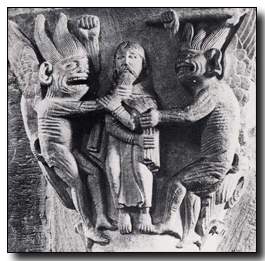Haunted House
- MARK GAUVREAU JUDGE
This Halloween, when I go trick-or-treating with my nephews, I'm dressing as an 18th-century Russian-born priest. Halloween is supposed to be about what's scary, and what Demetrius Augustine Gallitzin encountered - called by the Baltimore Catholic Review the "truest ghost story ever told" - sounds scary enough.
 |
Gallitzin's
father was Prince Demetrius Alexievitz Gallitzin, Russian ambassador to France
and then Holland, who numbered Diderot and Voltaire among his friends. His mother
was the Countess Amalie von Schmettau, a devout Catholic and considered by one
observer "the most brilliant woman in Europe." When the son was 17, in 1787, he
too became a Catholic, adding the "Augustine" as a confirmation name.
At age 22, Gallitzin traveled to the New World, entering St. Mary's seminary in Baltimore. He was moved by the needs of the early American church, which only had a handful of priests to cover the million square miles. Contrary to the wishes of his friends and relatives back home, Gallitzin became a priest in 1795, going by the last name Smith so that no one would suspect he was royalty. He was sent to Conewago, a tiny outpost in the wilds of what would become western Maryland, western Pennsylvania and the Shenandoah Valley of Virginia.
While Gallitzin was making his way in the New World, something strange was happening in what is today West Virginia. In the 1790s, Adam Livingston, a Lutheran who lived on an estate in the Shenandoah valley with his wife and children, began to witness weird happenings in and around his house. Cattle died without explanation. Worse, the Livingstons were kept awake at night by the sound of galloping horses and wagons charging through their living room. Furniture moved by itself and crockery smashed to the floor. The family often heard the sound of shears and scissors, and the clothing they owned was cut to pieces by an invisible force, or so they claimed, often into crescent shapes. Soon the town, many of whose members said that they saw the frightening occurrences themselves, started calling the Livingston estate "The Wizard's Clip" and "Cliptown," names still in use today.
Livingston begged a local Episcopal minister for help. The man, named Alexander Balman, had been a chaplain in the Revolutionary War, but his courage did him no good with the Clip. One account claims he "attempted an exorcism, and was famously abused by the scornful spirit, so that the prayerbook he used was found subsequently in one of the rooms, in a place which indicated no great respect for our admirable liturgy on the part of the ghost."
Livingston tried sorcerers, who also failed. Shortly after, he had dream: He was climbing a mountain and when he reached the top saw a beautiful church and a "minister dressed in peculiar robes." Livingston was informed that a minister in robes had to be a Catholic priest. He traveled to Shepardstown, where he met Father Dennis Cahill.
Livingston was stunned: Father Cahill, he said, was the man he had seen in his dream. The priest said prayers and sprinkled holy water around the house. Some money that had been lost suddenly appeared, as if carried by invisible hands, and was laid on a mantlepiece. For several days the house was quiet, but then the trouble started again, and the bishop of Baltimore, John Carroll, decided to send another priest to conduct an investigation Father Gallitzin.
Gallitzin stayed three months. His lengthy account of the spirits at the Wizard's Clip has been lost, but there are surviving letters and the accounts of those who knew him. He started as a skeptic but, after interviewing witnesses and seeing the phenomena himself, changed his mind.
Father Cahill ultimately drove the spirits out. Livingston became a Catholic and claimed that strange things kept happening in his house, except now they were holy. He frequently heard a voice that instructed him in Catholic dogma and demanded that the Livingstons pray. He also claimed that a bearded, barefoot stranger appeared in his house and stayed for four days, instructing him in the faith. As the stranger was leaving through their field he simply disappeared, leading the family to refer to him as an angel.
At the prompting of the voice, Livingston donated some of his land to the church, which still owns it. As a result of his conversion, Gallitzin forfeited his royal inheritance. But he dedicated everything he owned, which wasn't much, to establishing a church in western Pennsylvania. In 1840 he died penniless and today is largely forgotten though perhaps not in the town of Gallitzin, Pa., pop. 1,700 and 95% Catholic.
 This is Meaghen Gonzalez, Editor of CERC. I hope you appreciated this piece. We curate these articles especially for believers like you.
This is Meaghen Gonzalez, Editor of CERC. I hope you appreciated this piece. We curate these articles especially for believers like you.
Please show your appreciation by making a $3 donation. CERC is entirely reader supported.

Acknowledgement
Mark Gauvreau Judge. "Haunted House." The Wall Street Journal (October 31, 2003).
This article reprinted with permission from Opinion Journal of
The Wall Street Journal editorial page.
 |  |  |
The Author
Mark Gauvreau Judge is the author of Damn Senators: My Grandfather and the Story of Washington's Only World Series Championship, If It Ain't Got That Swing: The Rebirth of Grown-Up Culture, and Wasted: Tales of a Genx Drunk. He writes for New York Press.
Copyright © 2003 Wall Street Journal



